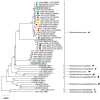Canary Bornavirus (Orthobornavirus serini) Infections Are Associated with Clinical Symptoms in Common Canaries (Serinus canaria dom.)
- PMID: 36298742
- PMCID: PMC9607494
- DOI: 10.3390/v14102187
Canary Bornavirus (Orthobornavirus serini) Infections Are Associated with Clinical Symptoms in Common Canaries (Serinus canaria dom.)
Abstract
While parrot bornaviruses are accepted as the cause of proventricular dilatation disease (PDD) in psittacine birds, the pathogenic role of bornaviruses in common canaries is still unclear. To answer the question of whether canary bornaviruses (species Orthobornavirus serini) are associated with a PDD-like disease in common canaries (Serinus canaria f. dom.), the clinical data of 201 canary bird patients tested for bornaviruses using RT-PCR assays, were analyzed for the presence of PDD-like gastrointestinal or central nervous system signs and for other viruses (mainly circovirus and polyomavirus), yeasts and trichomonads. Canary bornavirus RNA was detected in the clinical samples of 40 out of 201 canaries (19.9%) coming from 28 of 140 flocks (20%). All nucleotide sequences obtained could unequivocally be determined as canary bornavirus 1, 2, or 3 supporting the current taxonomy of the species Orthobornavirus serini. PDD-like signs were found associated with canary bornavirus detection, and to a lesser extent, with circoviruses detection, but not with the detection of polyomaviruses, yeasts or trichomonads. The data indicate that canary bornaviruses contribute to a PDD-like disease in naturally infected canaries, and suggest a promoting effect of circoviruses for the development of PDD-like signs.
Keywords: Macrorhabdus; avian bornavirus; canary bornavirus; circovirus; coinfection; domestic canary; natural infection; pathogenicity; polyomavirus; proventricular dilatation disease.
Conflict of interest statement
The authors declare no conflict of interest.
Figures

References
-
- Honkavuori K.S., Shivaprasad H.L., Williams B.L., Quan P.L., Hornig M., Street C., Palacios G., Hutchison S.K., Franca M., Egholm M., et al. Novel borna virus in psittacine birds with proventricular dilatation disease. Emerg. Infect. Dis. 2008;14:1883–1886. doi: 10.3201/eid1412.080984. - DOI - PMC - PubMed
-
- Kistler A.L., Gancz A., Clubb S., Skewes-Cox P., Fischer K., Sorber K., Chiu C.Y., Lublin A., Mechani S., Farnoushi Y., et al. Recovery of divergent avian bornaviruses from cases of proventricular dilatation disease: Identification of a candidate etiologic agent. Virol. J. 2008;5:88. doi: 10.1186/1743-422X-5-88. - DOI - PMC - PubMed
-
- Rubbenstroth D., Brosinski K., Rinder M., Olbert M., Kaspers B., Korbel R., Staeheli P. No contact transmission of avian bornavirus in experimentally infected cockatiels (Nymphicus hollandicus) and domestic canaries (Serinus canaria forma domestica) Vet. Microbiol. 2014;172:146–156. doi: 10.1016/j.vetmic.2014.05.011. - DOI - PubMed
MeSH terms
Substances
LinkOut - more resources
Full Text Sources

